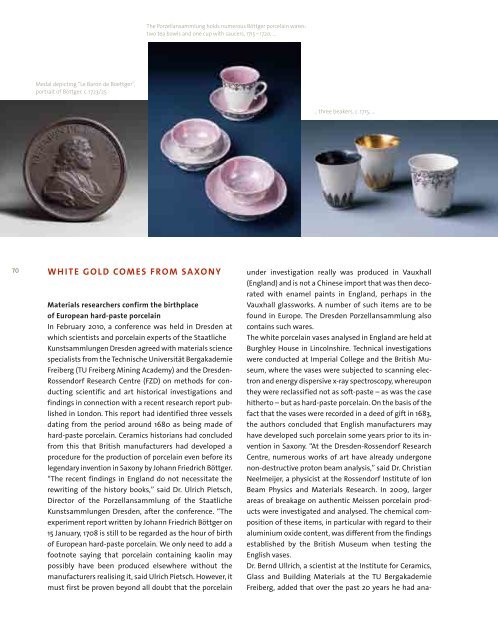Annual Report 2010 - Staatliche Kunstsammlungen Dresden
Annual Report 2010 - Staatliche Kunstsammlungen Dresden
Annual Report 2010 - Staatliche Kunstsammlungen Dresden
You also want an ePaper? Increase the reach of your titles
YUMPU automatically turns print PDFs into web optimized ePapers that Google loves.
Medal depicting “Le Baron de Boettger”,<br />
portrait of Böttger, c. 1723/25<br />
70 WH Ite GolD CoMeS FRoM SAXonY<br />
The Porzellansammlung holds numerous Böttger porcelain wares:<br />
two tea bowls and one cup with saucers, 1715 – 1720, …<br />
Materials researchers confirm the birthplace<br />
of european hard-paste porcelain<br />
In February <strong>2010</strong>, a conference was held in <strong>Dresden</strong> at<br />
which scientists and porcelain experts of the <strong>Staatliche</strong><br />
<strong>Kunstsammlungen</strong> <strong>Dresden</strong> agreed with materials science<br />
specialists from the Technische Universität Bergakademie<br />
Freiberg (TU Freiberg Mining Academy) and the <strong>Dresden</strong><br />
Rossendorf Research Centre (FZD) on methods for conducting<br />
scientific and art historical investigations and<br />
findings in connection with a recent research report published<br />
in London. This report had identified three vessels<br />
dating from the period around 1680 as being made of<br />
hardpaste porcelain. Ceramics historians had concluded<br />
from this that British manufacturers had developed a<br />
procedure for the production of porcelain even before its<br />
legendary invention in Saxony by Johann Friedrich Böttger.<br />
“The recent findings in England do not necessitate the<br />
rewriting of the history books,” said Dr. Ulrich Pietsch,<br />
Director of the Porzellansammlung of the <strong>Staatliche</strong><br />
<strong>Kunstsammlungen</strong> <strong>Dresden</strong>, after the conference. “The<br />
experiment report written by Johann Friedrich Böttger on<br />
15 January, 1708 is still to be regarded as the hour of birth<br />
of European hardpaste porcelain. We only need to add a<br />
footnote saying that porcelain containing kaolin may<br />
possibly have been produced elsewhere without the<br />
manufacturers realising it, said Ulrich Pietsch. However, it<br />
must first be proven beyond all doubt that the porcelain<br />
… three beakers, c. 1715, …<br />
under investigation really was produced in Vauxhall<br />
(England) and is not a Chinese import that was then decorated<br />
with enamel paints in England, perhaps in the<br />
Vauxhall glassworks. A number of such items are to be<br />
found in Europe. The <strong>Dresden</strong> Porzellansammlung also<br />
contains such wares.<br />
The white porcelain vases analysed in England are held at<br />
Burghley House in Lincolnshire. Technical investigations<br />
were conducted at Imperial College and the British Museum,<br />
where the vases were subjected to scanning electron<br />
and energy dispersive xray spectroscopy, whereupon<br />
they were reclassified not as softpaste – as was the case<br />
hitherto – but as hardpaste porcelain. On the basis of the<br />
fact that the vases were recorded in a deed of gift in 1683,<br />
the authors concluded that English manufacturers may<br />
have developed such porcelain some years prior to its invention<br />
in Saxony. “At the <strong>Dresden</strong>Rossendorf Research<br />
Centre, numerous works of art have already undergone<br />
nondestructive proton beam analysis,” said Dr. Christian<br />
Neelmeijer, a physicist at the Rossendorf Institute of Ion<br />
Beam Physics and Materials Research. In 2009, larger<br />
areas of breakage on authentic Meissen porcelain products<br />
were investigated and analysed. The chemical composition<br />
of these items, in particular with regard to their<br />
aluminium oxide content, was different from the findings<br />
established by the British Museum when testing the<br />
English vases.<br />
Dr. Bernd Ullrich, a scientist at the Institute for Ceramics,<br />
Glass and Building Materials at the TU Bergakademie<br />
Freiberg, added that over the past 20 years he had ana

















